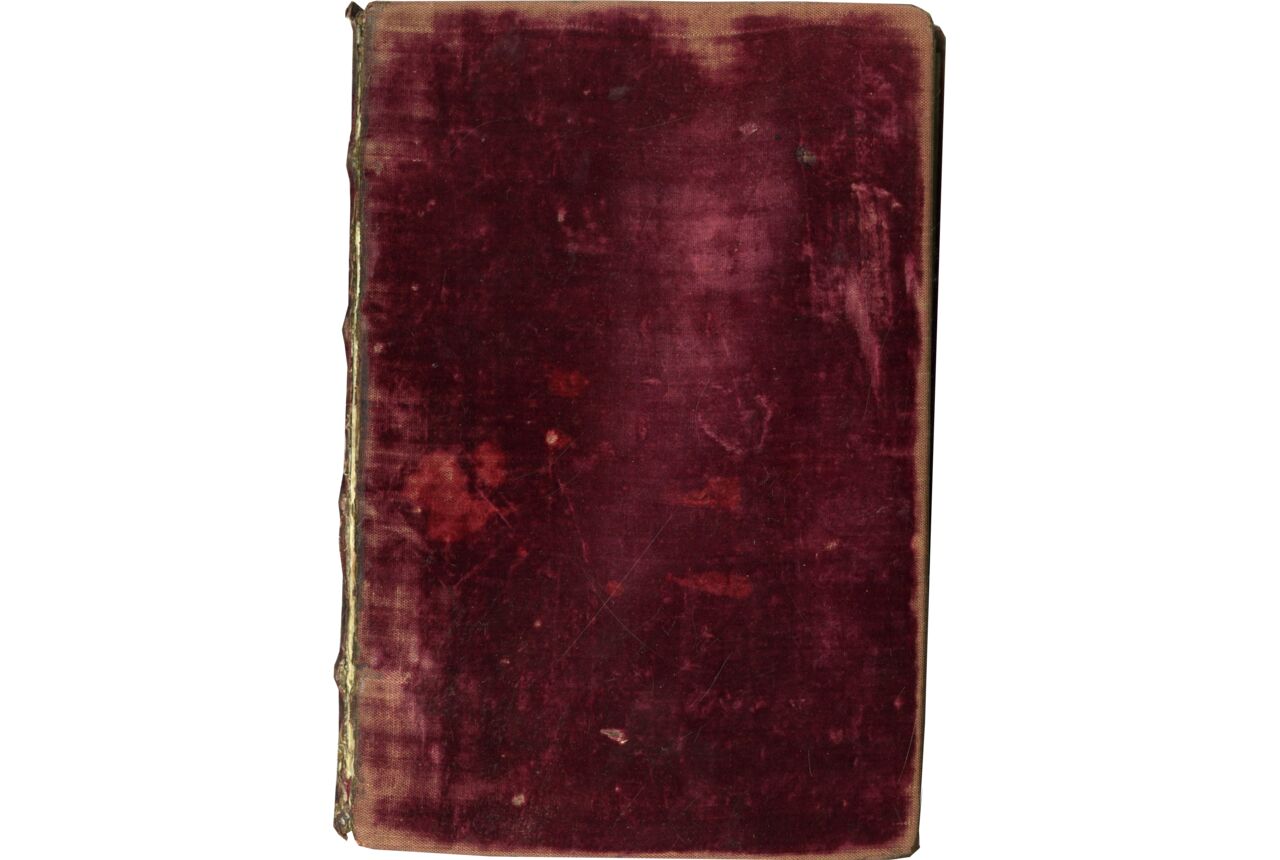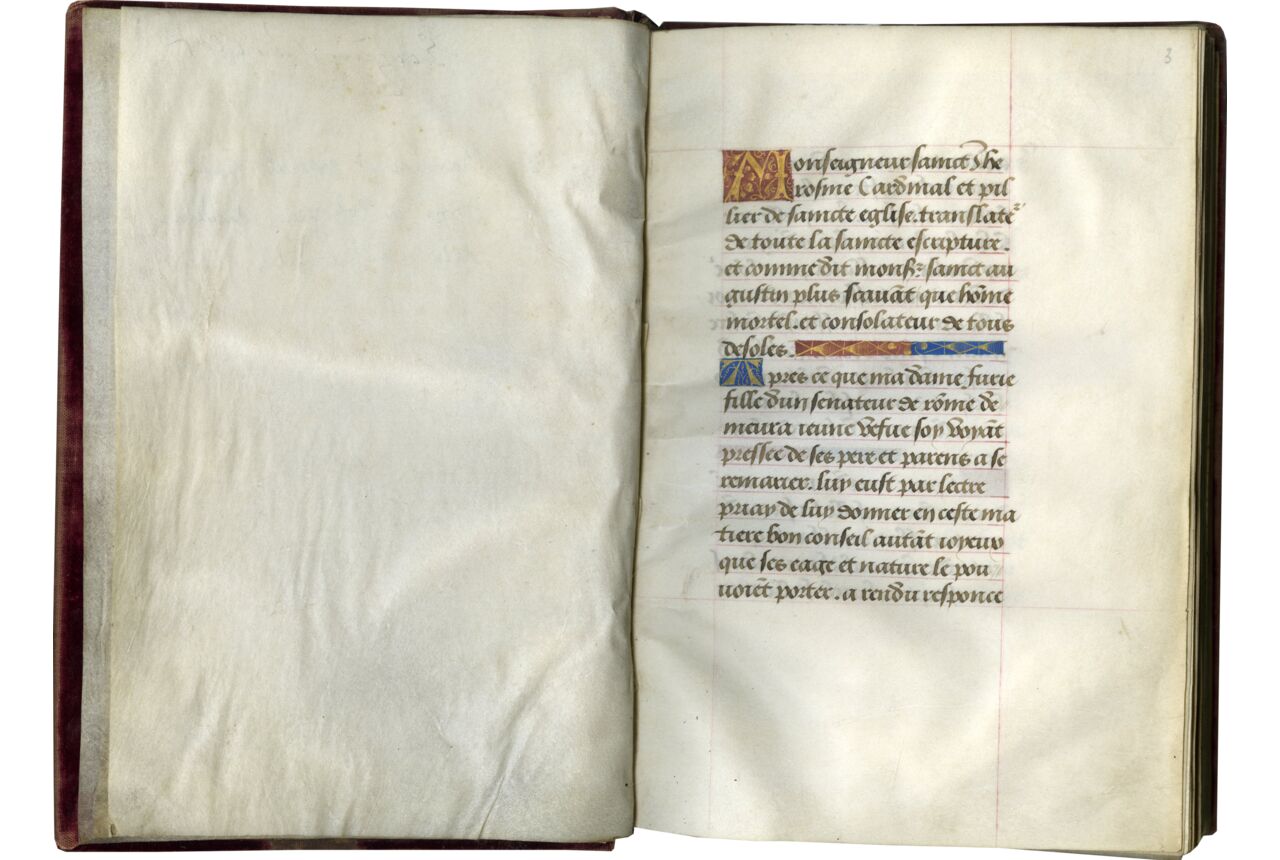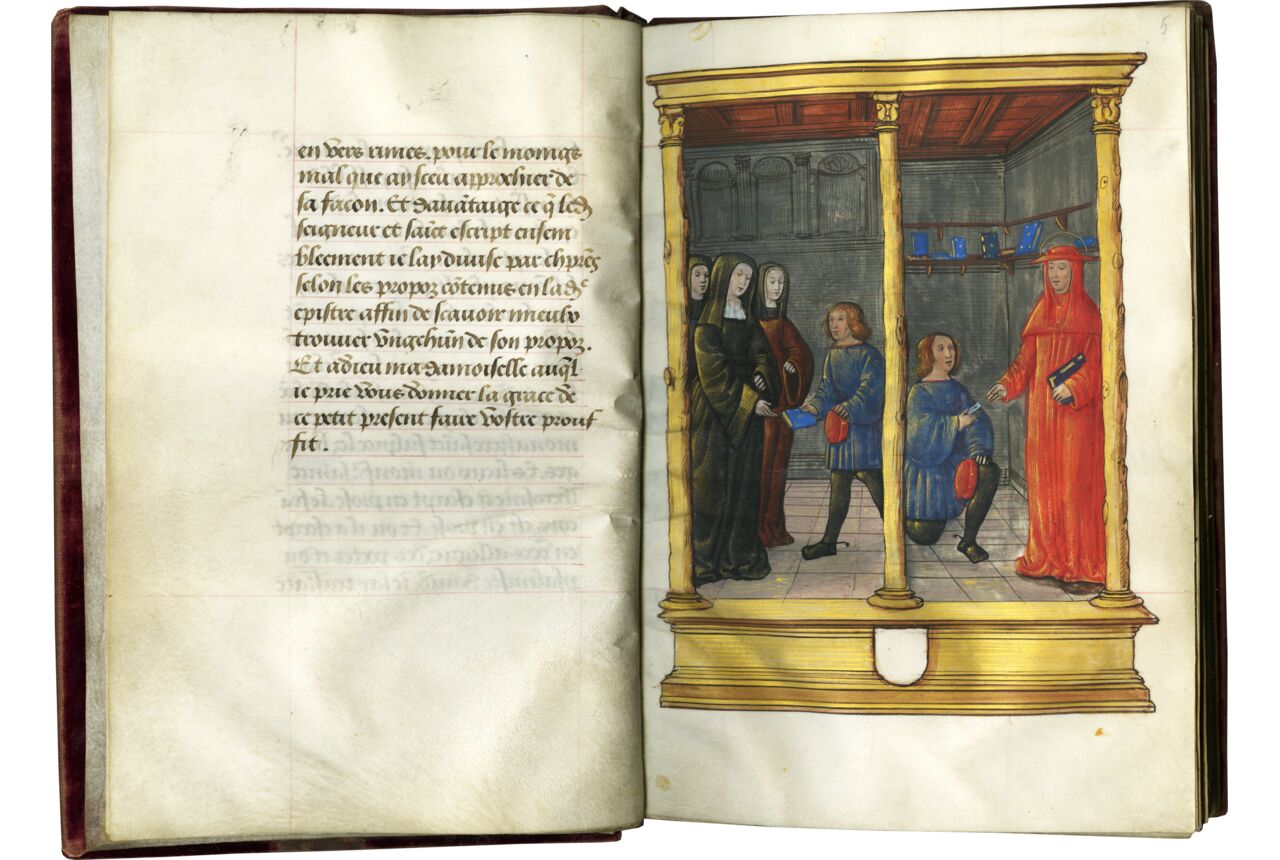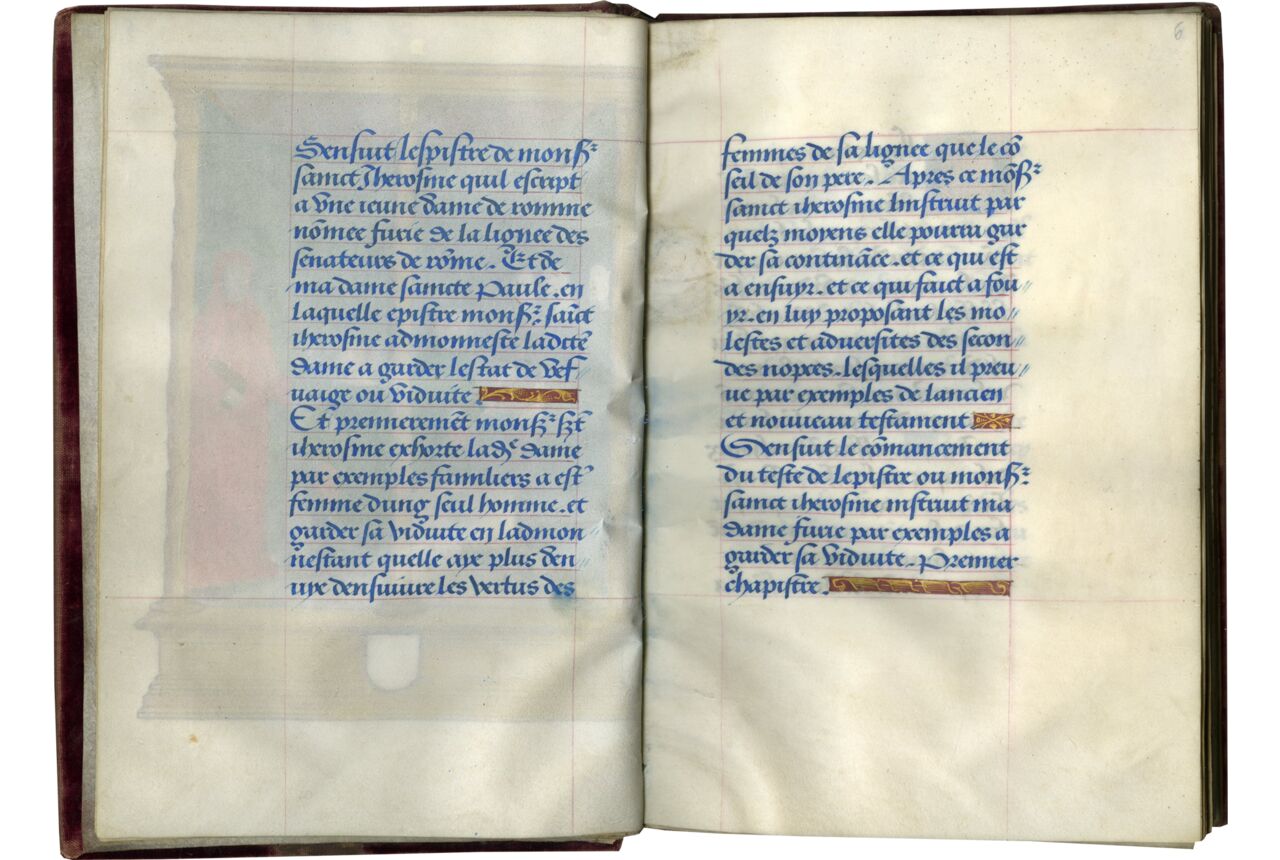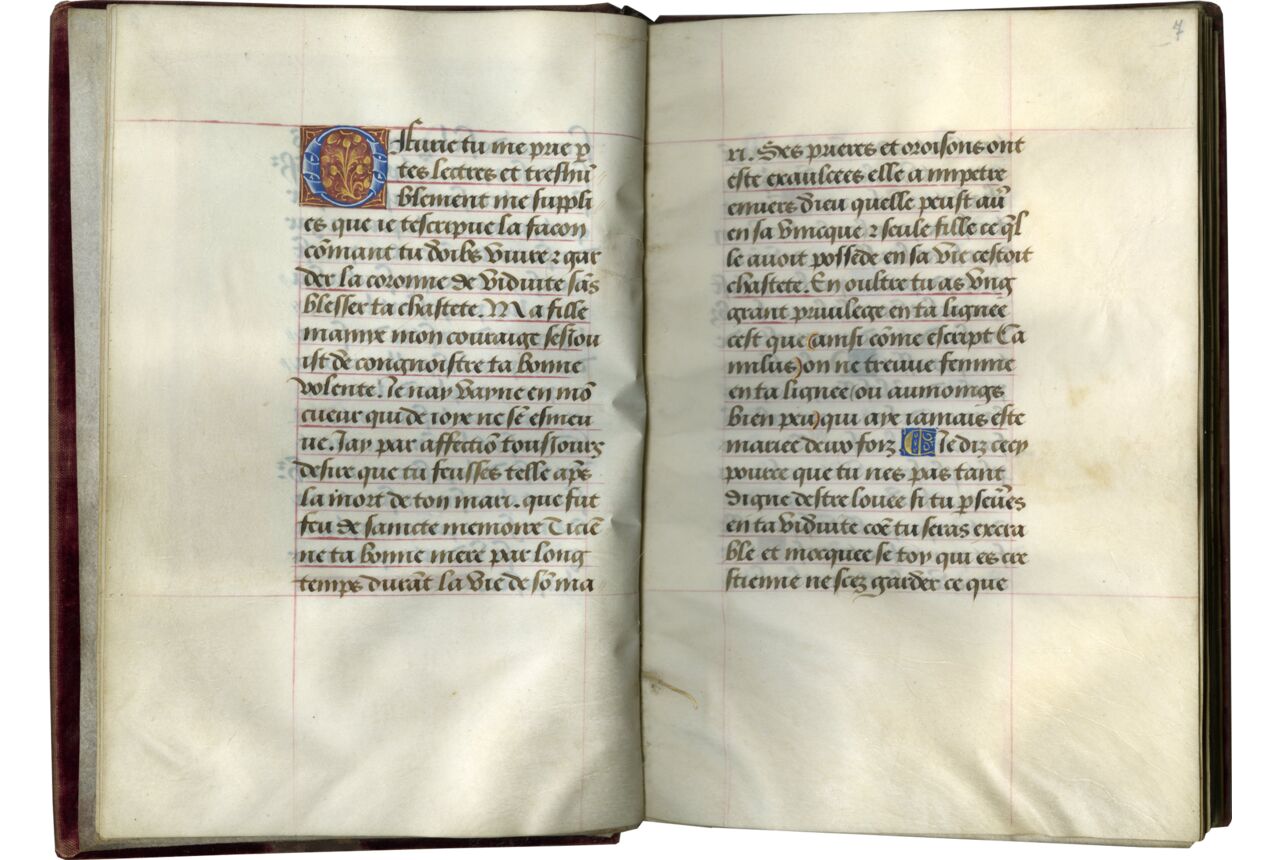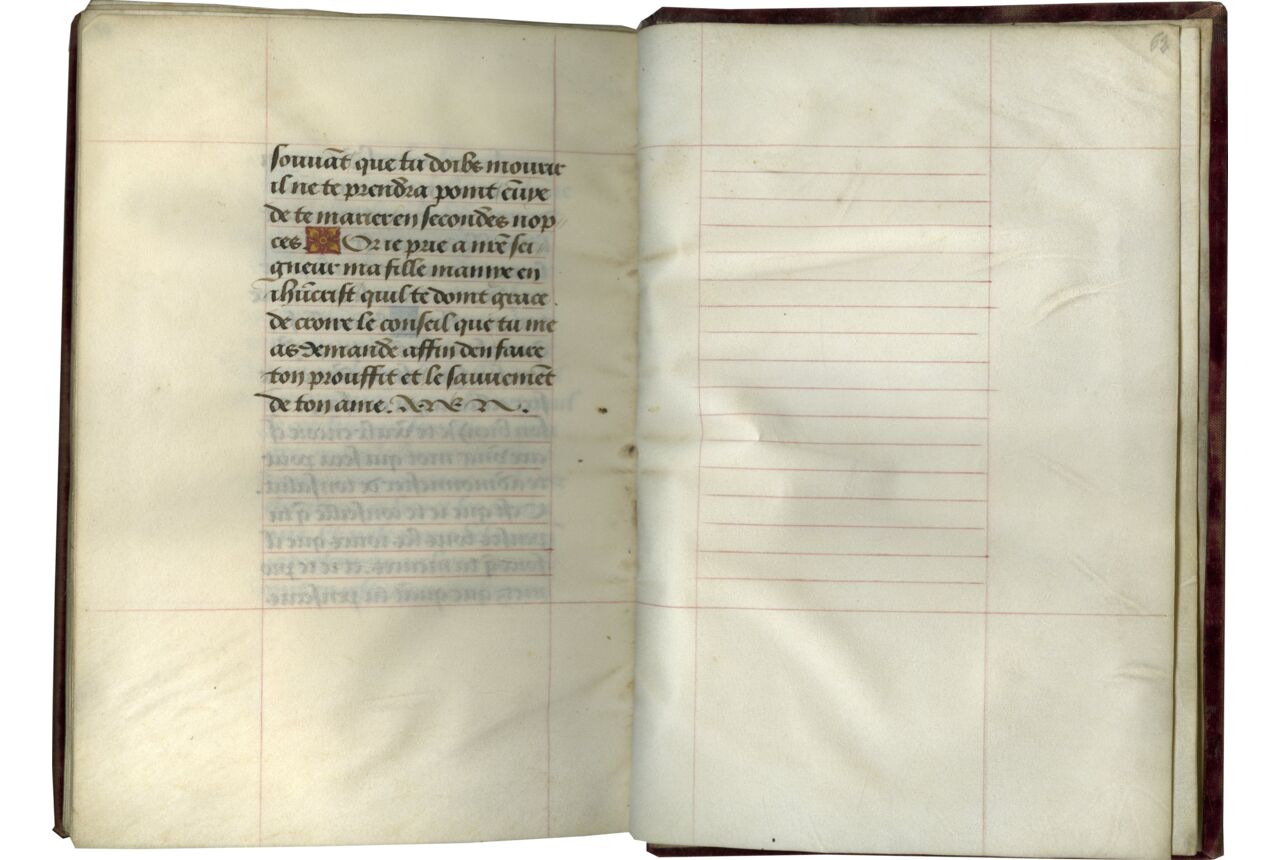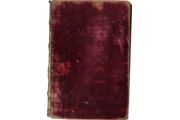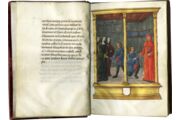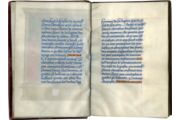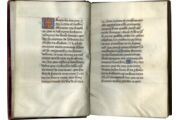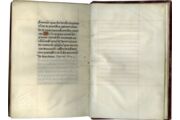63 folios (f. 1 is a pastedown, f. 2 blank, text running from ff. 3-61v, ff. 62- 63 blank, final leaf is a pastedown), gatherings mostly in quires of 8 (collation i2 [ff. 1-2] ii-viii8 [ff. 3-58] ix4 [ff. 59-62] x2 [f. 63 + unfoliated leaf]), written in brown ink in a lettre bâtarde on up to 17 lines (justification 115 x 70 mm.), ruled in red, rubrics in blue, paragraph marks in liquid gold on blue or dark red grounds, line-fillers in liquid gold on blue or red grounds, one- to two- line initials, paragraph marks and line-fillers in gold on red or blue grounds highlighted in liquid gold, three-line initial in blue highlighted in white on a red ground with floral gold decoration (f. 6v), one full-page miniature set in a liquid gold architectural frame (f. 5), manuscript in fresh colors with wide margins. CONTEMPORARY BINDING of purple velvet (worn) over wooden boards, gilt edges, hinges fragile, but nonetheless in good condition for an original velvet binding;, in an articulated black morocco box. Dimensions 210 x 135 mm.
In its original purple velvet binding and adorned with a frontispiece painted by the Master of Spencer 6, this deluxe, carefully fashioned manuscript presents a unique copy of a French translation by a hitherto unknown translator of Saint Jerome’s letter to the widow Furia. Owned by a woman of the French aristocracy, Anne de Polignac, who was widowed twice, this manuscript invites us to re-examine her remarkably varied library of some thirty-six manuscripts, most in the vernacular, raising questions pertaining to female book ownership and literary and artistic patronage in the first decades of the sixteenth century, and the nature of the reading experiences of French Renaissance women.
Provenance
1.Manuscript copied in Bourges or the Berry region, as suggested by the dedicatory prologue of the translator Charles Bonin who states that his translation was reviewed and corrected by a certain “Jehan Fernaud aveugle treshabille homme et devost religieux reformé au monastere saint Sulpice lez Bourges” (f. 4). A berrichon origin is confirmed by stylistic elements tied to the full-page illumination attributed to the Master of Spencer 6, an artist active in Bourges.
Katja Airaksinen-Monier has recently proposed Louise de Savoie (1476-1531) as the original owner of our manuscript; Louise was widowed at age nineteen in 1496, and refused to remarry. She was a great admirer of St. Jerome, and owned at least two other manuscripts, both in French, painted by the Master of Spencer 6 (Airaksinen-Monier, 2018, p. 117 and note 1).
2.Anne de Polignac (1495-1554), dame de Randan et de Beaumont. On her library see L. Delisle, 1880; Quentin Bauchart, 1886; and Cahn, 2005. Her first husband, Charles du Bueil, Count of Sancerre, was killed at the Battle of Marignan in 1515. In 1518 she married François II de La Rochefoucauld, who died in 1533 (La Chesnaye-Desbois, Dictionnaire de la noblesse, 1778, tome XII, p. 201). Her library was housed in her castle at Verteuil near Angoulême and was inventoried at the death of Duke François VIII de La Rochefoucauld in 1728 (see Archives départementales de la Charente, E 662, published by P. de Fleury, 1885-1886, p. 181 for this manuscript, and in greater detail, M. Gérard, 1984, pp. 244-245 for this manuscript). Toward the middle of the eighteenth century, the Verteuil library was transferred by the Duke Alexandre de La Rochefoucauld to his château at La Roche-Guyon. Upon the death of his childless grandson and heir in 1792, the Verteuil library came into the possession of Louis-François Auguste, Cardinal de Rohan-Chabot who was a Rochefoucauld through his mother.
3.Louis-François Auguste, Cardinal de Rohan-Chabot (1788-1833) moved part of the Verteuil library to his castle at Josselin in Brittany, which was in need of restoration. In order to raise funds, thirty-six manuscripts of Anne de Polignac’s library were placed on sale at auction in Paris by Adolphe Labitte in 1879 (Labitte, 1879, no. 10 for this manuscript). The description in the 1728 inventory of an “Espitre de st hierosme a une dame romaine. Manuscrit” is rather summary. The detailed description in Labitte’s auction catalogue of 1879, however, confirms an identification with the present manuscript. His number ten is described as follows: “10. Sensuit Lespistre de Monseigneur Sainct Jherosme, qu’il escript a une jeune dame de Romme nommee Furie. En laquelle espistre Monseigneur sainct Jherosme admoneste la dicte dame a garder lestat de vefuaige ou viduité.”
4.Eugène Paillet (1829-1901), a highly regarded bibliophile and president of the “Société des Amis des Livres,” with his inscription in brown ink (f. 2). The present codex is listed in H. Beraldi, Bibliothèque d’un Bibliophile, 1865-1885, Lille, 1885, p. 1, no. 3. Sale of his first library en bloc in 1887 to the Librairie Damascène Morgand: listed in its catalogue as number 389 (Catalogue des Livres de la Bibliothèque de M. Eugène Paillet, Paris, 1887, no. 389; see also D. Gamut, “The Paillets in New York,” The New York Times, 23 March 1890, p. 12).
5.Inscribed in black ink inside back cover in the upper right corner: “Ingr. 2341.”
Text
ff. 3-4v, Prologue of the translator Charles Bonin addressed to his “treshonnorée damoiselle” (f. 3v), incipit, “Monseigneur sainct Iherosme cardinal et pillier de saincte eglise, translateur de toute la saincte escripture...La quelle, je Charles Bonin presbtre indigne ay voulu translater pour l’onneur de vous ma treshonorée damoiselle...”;
ff. 5v-10v, rubric (in blue), S’ensuit l’espistre de monseigneur sainct Jherosme qu’il escript a une ieune dame de romme nommée furie de la lignee des senateurs de romme. Et de madame saincte Paule en laquelle epistre monseigneur sainct iherosme admonneste ladite dame a garder l’estat de vefvaige ou viduité …;
ff. 6v-10v, [Jerome, Letter LIV to Furia, translated by Charles Bonin, chapter I], incipit, “O Furie tu me prie par tes lettres et treshumblement me supplies que je t’escripve la façon comment tu doibs vivre et garder la coronne de viduité sans blesser ta chasteté …”;
ff. 10v-17v, [Chapter II], Des remonstrances que monseigneur sainct Iherosme faict a ma dame furie pour la desmouvoir de se remarier. Chapitre IIe, incipit, “Je ne te devoys point parler des douleurs de mariage pour ce que tu en as assez aprins en tes propres nopces et mariage …”;
ff. 17v-23v, [Chapter III], Comment monseigneur sainct Iherosme exhorte par exemples ma dame Furie a garder sa viduité. Chapistre troisiesme, incipit, “Ce que iay dit cy davant ma tresamée fille en Ihesucrist, ie ne le dy point doubtant de ton bon propoz …”;
ff. 23v-28, [Chapter IV], Des inconveniens qui adviennent aux femmes pour vivre delicieusement et a leurs plaisirs. Chapitre IIIIe, incipit, “Une femme vesve qui est nourrie en delices et a son plaisir elle est morte en vivant.…”;
ff. 28-34v, [Chapter V], Des viendes que l’on doibt user pour garder chasteté. Chapitre Ve, incipit, “Les medecins qui ont congneu et escript les natures des corps humains disent et par especial Galien en ses livres intitulés en grec ...”;
ff. 34v-36v, [Chapter VI], De la façon de prier dieu et de pluseurs inconveniens qui sont a eviter. Chapitre Vie, incipit, “Et pource ma fille ma mye que ie tay dit que tu doibs tousiours penser a prier dieu ...”;
ff. 36v-38v, [Chapter VII], Du bien qui vient de donner l’aumosne pour l’onneur de dieu. Et a qui l’on doibt donner. Chapistre VIIe, incipit, “Acquiers et saiz des amis de ton argent et de tes biens temporelz en les donnants aux pouvres ...”;
ff. 38v-41, [Chapter VIII], Des compagnies qui sont a fuyr. Chapitre VIIIe, incipit, “Fuy la compagnie des jeunes hommes ...”;
ff. 41-43, [Chapter IX], De la façon de se corriger et considerant les mauvaises condictions d’aultruy. Chapitre IXe, incipit, “Nous avons veu depuis peu de temps en ça par tout le pays d’orient une facon de vivre tres deshonneste ...”;
ff. 43-46v, [Chapter X], De l’exemple de la seur de furie affin de la ressembler en meurs. Chapistre Xe, incipit, “A ma fille mamye si tu vois ta seur qui a renommee au monde ...”;
ff. 46v-48, [Chapter XI], Les excusacions des femmes vefues qui se veulent marier. Chapitre Xie, incipit, “Les femmes qui ont en vye delles marier desquelles les aucunes ont laisse le chemin de paradis et se sont retournées en arriere ...”;
ff. 48-51v, [Chapter XII], Des repliques de mariage. Chapistre XIIe, incipit, “La mere qui se marie deux fois ne espouse pas ung nourrcier a ses enfans mais ung ennemi …”;
ff. 51v-61v, [Chapter XIII] Quelles doibvent estre les femmes vefues. Chapistre XIIIe, incipit, “Si nous voulons sçavoir quelles doivent estre les femmes vefves lisons l’evangille de monseigneur sainct Luc ...”; [ff. 62-63v, blank].
Illustration
f. 5, Full-page frontispiece miniature showing St. Jerome giving his epistle to a messenger, and the messenger handing it to Furia, the intended recipient. The two scenes are presented side by side in a divided space in an architectural framework. St. Jerome, standing on the right, is dressed as a cardinal, wearing a red robe and a hat. He is shown handing his letter destined to Furia to a messenger kneeling in front of him. The adjoining scene on the left shows the messenger handing the letter (which has now become a book) to Furia who is dressed in noble black and accompanied by two women (ladies in waiting?). In both scenes the messenger wears a short blue robe, tall black boots with spurs, and a red cape. The framing columns, which support a simple architrave, are made of tree trunks and stand on a high plinth inscribed with a space for heraldic arms.
This elegant frontispiece miniature is attributable to the Master of Spencer 6, who takes his name from the eponymous manuscript in the New York Public Library (see J. Plummer, 1982, no. 95A; Avril and Reynaud, 1993, p. 343; Alexander, et al., 2005, no. 62). Generally the artist painted Books of Hours (see Avril and Reynaud, 1993, pp. 343-345; Airaksinen-Monier, 2014 and 2018, discussing our manuscript p. 117 and note 1), which gives this manuscript particular importance within his oeuvre as a work of lay rather than devotional literature. The collaboration with other workshops indicates that the Master of Spencer 6 was active in Bourges and the artist might be identical with a certain Laurent Boiron, who is documented in Bourges between 1480 and 1510, sometimes called bookseller (as suggested by Jean-Yves Ribault, see Avril and Reynaud, 1993, p. 343; Exhibition New York Public Library, p. 279). Typical of his work are the pale skin tones and pronounced facial features. He depicts his figures in dominant colors contrasting with light color schemes for interiors. The tall columnar figures in this manuscript indicate a date around 1500. The idea of using tree trunks (“bois écotés”) as columns to frame the miniature is inherited from the circle of Jean de Monluçon, as can be seen in a Book of Hours around 1500 in Paris, BnF, MS n.a.l. 3116 (see Avril and Reynaud, 1993, no. 188), but also in the Hours of New York Public Library, Spencer 6 (Alexander, et al., 2005, pp. 278 and 280).
This manuscript contains the only known copy of a French translation by Charles Bonin of Jerome’s Letter LIV to Furia. The translator Charles Bonin refers to himself as “priest” in the prologue and could be a member of the Bonin de la Bonninière family (from Touraine; see Dictionnaire des familles françaises..., Évreux, 1904, III, pp. 216-220) or Bonin de Corpoy family, well-established in Bourges (see Thaumas de la Thaumassière, 1689, pp. 1037-1038; Dictionnaire des familles françaises..., III, pp. 220 et sqq).
This epistolary work in twelve chapters presents a letter of guidance to a widow named Furia on the best means of preserving her widowhood. Furia had at one time thought of remarrying but eventually changed her mind and devoted herself to the care of her young children and ageing father. Jerome draws a vivid picture of the dangers to which she is exposed at Rome, lays down rules of conduct for her guidance, and commends her to the care of the presbyter Exuperius (afterwards bishop of Toulouse). Jerome takes the occasion to disparage the married state vehemently, to discourage her from ever thinking of it again despite pressure from her family, and then outlines a life of devotion, denial and good works. He includes examples of strong and virtuous women from the Bible and one from contemporary life, Marcella. The date of the letter is probably circa 394/395 A.D. (Nautin, 1974, pp. 257-63). The original Latin is published most recently in Conring, 2001, pp. 170-98.
The subject of widowhood, much examined in the early Renaissance, emerges as central to the theme of the social status of powerful women. Given that widowhood often accorded women greater independence, the status was not necessarily a negative one for women, as Jerome argues in his Epistle to Furia. In times of war and strife, such as during the Italian Wars in France, widowhood was a common state for women, reflected in images such as those representing Anne of Brittany (see Brown, 2011, in particular chapter “Famous Women in Mourning,” pp. 181-244), Louise de Savoy (see Lecoq, 1989), and Catherine de’ Medici (figured as “Artemisia,” see Ffolliott, 1986), and it developed into a literary topos with pictorial expressions (see Levy, 2003). Literary texts devoted to widowhood also circulated with the development of the plaint motif (“complainte”) and in texts of sorrow, of mourning, or about death in general, such as those composed by Jean Lemaire de Belges.
Dedicated to an unidentified “tres honorée damoiselle,” Charles Bonin’s translation of Jerome’s Letter LIV to Furia was, according to the prologue, reviewed by a certain Brother Jehan Fernaud of the monastery of Saint-Sulpice-lès-Bourges (this is of interest, given the miniature was likely painted in Bourges). The manuscript has long been traced to the library of Anne of Polignac, who is its earliest identifiable owner. Born c. 1495 (died 1554), Anne was “dame d’Onzain, de Rendans (Randan) et du Luguet,” a member of the illustrious Polignac family. She was herself a widow twice, first in 1515 when her first husband Charles de Bueil died at Marignan, and again in 1533 when her second husband François II de la Rochefoucauld died. Since she was twice widowed, Anne would have found the present text of special interest, and it might have been offered to her in this context. She died in her favored castle at Verteuil-sur- Charente (near Angoulême) which housed her collection of books.
The works in Anne de Polignac’s library have been studied by Delisle as a group (1880) and by Quentin-Bauchart (1886), who lists some twenty-eight manuscripts owned by her, many bound in similar velvet (velours, velours vert, rouge, jaune); and by Cahn (2003) who records thirty-six manuscripts. Although only a handful of these manuscripts have been traced, some observations can be made on her reading matter. Apart from a Bible and some books of private devotion (Horae, Preces piae, Psalter) in Latin, her preferred reading language was French, and she owned diverse devotional, historical, and literary works in the vernacular. There was, for example, another translation related to Jerome, a Vie, mort et myracles du glorieux sainct Jherosme (Cahn, 2005, no. 9). Among the historical works there was a copy of Philippe de Commynes’s Memoires (Anne was his niece) and the Chroniques de Bertrand du Guesclin (Cahn, 2005, nos. 35 and 36). Literary manuscripts include Chastelain’s Temple de Boccace (location unknown), the Triumphs of Petrarch in a French translation (see König, 1997), a book of verses by Margaret of Navarre (Cahn, 2005, no. 29; Chantilly, Musée Condé, MS 512), and an anthology of speeches by ancient authors, Harangues et oraisons (Yale University, Beinecke Library, MS 1042; see Cahn, 2005).
There has been increasing interest in lay women’s libraries, and although it is impossible to draw universal conclusions, the sixteenth century witnessed a clear movement favoring vernacular translations of moralizing, philosophical, and allegorical texts. Alluding implicitly to Anne of Polignac’s widowhood, this illuminated Letter to Furia in a new translation after Saint Jerome by a hitherto unknown (although identified) translator raises pivotal questions pertaining to female book ownership and literary and artistic patronage in the first decades of the sixteenth century.
The present work is typical of the vernacular works, both learned and moralizing, that women of the French aristocracy included in their libraries. The identification of Anne de Polignac as the actual dedicatee of this translation, however, seems difficult since she was born circa 1495 and the present manuscript was copied circa 1500, as suggested by the style of the full-page miniature. A treatise on maintaining one’s widowhood could hardly be addressed to a five- or even ten-year-old girl. In addition, the space for heraldic arms at the bottom of the frontispiece (f. 5) has been left blank. As noted above, Katja Airaksinen-Monier has recently proposed Louise de Savoie (1476-1531) as the original owner of our manuscript. Louise was the daughter of Philip II Duke of Savoy. She married Charles of Orléans, Count of Angoulême, in 1488; they had two children: Marguerite d'Angoulême and François (later King François I of France). Charles died in 1496, leaving Louise a widow at age nineteen. Louise resisted pressure to remarry, and was a great admirer of St. Jerome, and owned at least two other manuscripts, both in French, painted by the Master of Spencer 6 (Airaksinen-Monier, 2018, p. 117 and note 1).
Literature
Alexander, J.J.G., J. Marrow and L. F. Sandler. The Splendor of the Word: Medieval and Renaissance Illuminated Manuscripts at the New York Public Library, exh. cat., New York and London, 2005.
Anselme, P. Histoire généalogique et chronologique de la maison royale de France..., Paris, 1727, vol. IV, pp. 426-427.
Airaksinen-Monier, Katja. “Le Maître de Spencer 6 et ses commanditaires voyageurs,”
F. Elsig, ed. Peindre à Bourges aux XVe et XVIe siècles, Biblioteca d'arte 58, Milan, 2018, pp. 116-131.
Airaksinen-Monier, Katja, “Vision and Devotion in Bourges around 1500: An Illuminator and His World,” Ph.D. dissertation, University of Edinburgh, 2014.
Avril, F. and N. Reynaud, Les manuscrits à peintures en France 1440-1520, Paris, 1993, pp. 343-345.
Brown, C. J and M. W. Driver, eds. “Women and Book Culture in Late Medieval and Early Modern France,” Journal of the Early Book Society, 2001-4.
Cahn, W. “A French Renaissance Collection of Ancient Oratory from the Library of Anne de Polignac,” Yale University Library Gazette 79, no. 3-4 (2005), pp. 119-37, esp. pp. 129, 132, and 134 (“A copy of a French translation of St. Jerome’s Epistle to the Roman matron Furia, on the proper conduct of widows (No. 10 on Labitte’s list) was perhaps intended to console her on the death of her two husbands”).
Conring, B. Hieronymus als Briefschreiber, Tübingen, 2001, pp. 170-98.
Delisle, L. “La bibliothèque d’Anne de Polignac et les origines de l’imprimerie à Angoulême,” Mélanges de paléographie et de bibliographie, Paris, 1880, pp. 324-329, this manuscript p. 329.
Démorest, M. La dynastie de Polignac, 2010.
Fleury, P. de. “Inventaire des objets mobiliers existant dans les châteaux de La Rochefoucauld, Verteuil et La Terne à la mort de François VIII de La Rochefoucauld (1728),” Bulletin de la Société archéologique de la Charente, 5e ser., 7 (1884-85), pp. 71-209, this manuscript recorded p. 181.
Ffolliott, S. “Catherine de’ Medici as Artemisia: Figuring the Powerful Widow,” Rewriting the Renaissance. The Discourses of Sexual Difference in Early Modern Europe, Chicago and London, 1986, pp. 227-241.
Gérard, M. “Le catalogue de la bibliothèque de La Rochefoucauld à Verteuil,” in Images de La Rochefoucauld: Actes du Tricentenaire, 1680-1980, Paris, 1984, pp. 239-92, this manuscript recorded, pp. 244-245.
König, E. Boccaccio und Petrarca in Paris. Das Boccace de Nicolas-Joseph Foucault, Paris, 1460-1470...Der Petrarca der Anne de Polignac...Die früheste französische Trionfi-Handschrift... [Leuchtendes Mittelalter, I, no. 38], Heribert Tenschert, Ramsen, 1997.
Labitte, A. Catalogue de manuscrits précieux des XIIIe, XVe et XVIe siècles sur vélin et ornés de miniatures, Paris, Hôtel Drouot, 18 mars 1879, no. 10.
Levy, A. ed. Widowhood and Visual Culture in Early Modern Europe, Aldershot, 2003
Martin, G. Histoire et généalogie de la maison de Polignac, 2002
Nautin, F. “Études de chronologie hiéronymienne (393-397),” Revue des études augustiniennes 20 (1974), pp. 251-284, in particular pp. 257-63.
Plummer, J. The Last Flowering, exh. cat., New York, 1982, no. 95A.
Quentin Bauchart, E. Les femmes bibliophiles de France (XVIe, XVIIe & XVIIIe siècles), 2 vols, Paris, 1886, I, pp. 43-53, this manuscript recorded on p. 47 (with the name of the translator misread as “Sonin”)
Roissac, M. de. Généalogie de la très grande, très ancienne et très illustre maison de La Rochefoucaut, 1654.
Thaumas de la Thaumassière, G. Histoire de Berry, Paris, 2005 [facsimile of ed. 1689].
Online Resources
Jerome, Letter 54 to Furia (English translation) http://www.newadvent.org/fathers/3001054.htm
On Eugène Paillet and his collection https://library.leeds.ac.uk/special-collections/collection/1303
TM 935


